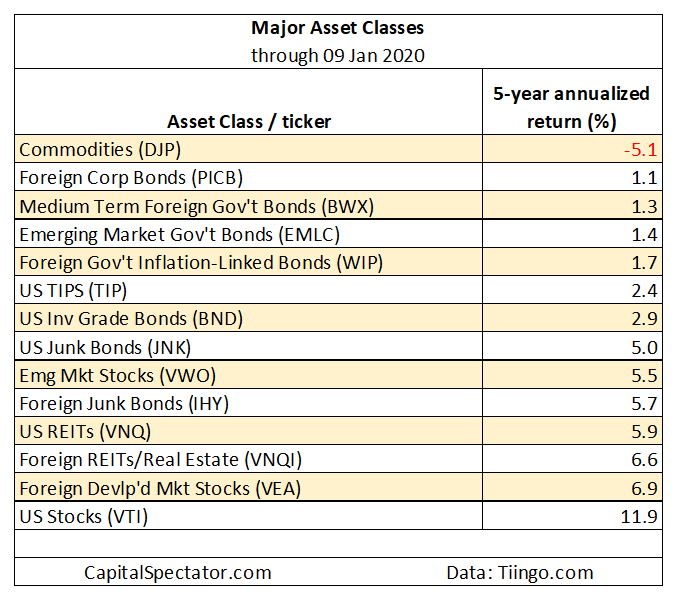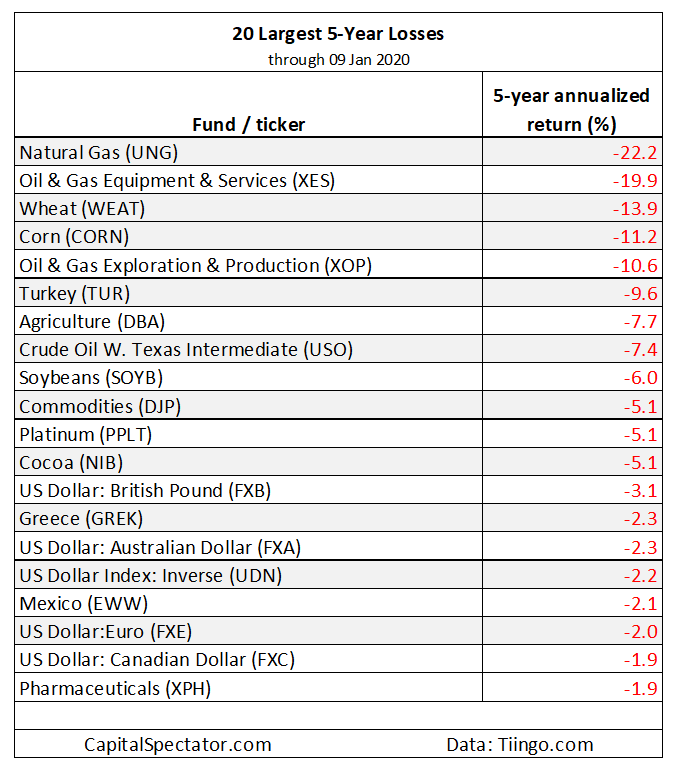Ben Graham famously described Mr. Market’s psychological state from day to day as vulnerable to erratic swings of optimism and pessimism. But recent history shows that the crowd’s exhibited a mostly stable view on commodities and energy by consistently discounting these assets by relatively aggressive standards, based on a set of exchange-traded products. That was true in our last update (Aug. 22, 2019) and remains so today.
As outlined below, sentiment has been tepid at best when it comes to raw materials and the companies engaged in processing oil, gas and other basic commodities. There are a handful of notable exceptions – gold, for instance, has been trending up in recent years. But across the broad sweep of commodities and energy, investors have cooled to the idea that assets in this corner deserve relatively high valuations.
Is Recession Risk Rising? Monitor the outlook with a subscription to:
The US Business Cycle Risk Report
Before we get into the details, a quick refresher on the ranking system used below. The metric of choice for “deep value” in this column is the 5-year return, which is based on an idea outlined in a paper by AQR Capital Management’s Cliff Asness and two co-authors: “Value and Momentum Everywhere,” published in a 2013 issue of the Journal of Finance. There are many value metrics and so no one should confuse the 5-year-performance benchmark as the definitive measure of bargain-priced assets. But as a starting point on the journey of identifying where the market’s outlook has fallen sharply, the 5-year change is a practical measure.
One advantage of us a 5-year performance measure: It can be applied over a broad set of assets, thereby dispensing a level playing field for evaluating value. Another plus: this metric is simple and therefore immune to estimation risk, which can complicate accounting-based value gauges, such as price-to-book and price-to-earnings measures. In short, the 5-year return is a handy tool as a first approximation for identifying ETFs that may be deeply discounted by the crowd — and thereby offer (possibly) relatively high expected returns via the value proposition for investing.
The standard caveat applies, of course, namely: there are no guarantees that value, no matter the definition, will lead to superior performance anytime soon, if ever. Recent history certainly shows that to be true. All the more so when it comes to commodities, fossil-based energy investments in particular. As the world grapples with the risk of climate change, there are predictions that the glory days for oil companies and the like have passed. In other words, energy stocks are arguably deeply discounted for a reason and so investors should go in with eyes wide open.
The ranking below covers 135 exchange-traded products that run the gamut: US and foreign stocks, bonds, real estate, commodities and currencies. You can find the full list here, sorted in ascending order by annualized 5-year return — 1260 trading days — through yesterday’s close, Jan. 9, 2020.
Keep in mind that the list is quite granular. In equities, for instance, the ETFs range from broad regional definitions (Asia, Latin America, etc,) to country funds, down to US sectors (energy, financials, for instance) and industries (e.g., oil & gas equipment & services). The only limitation is what’s available for US exchange-listed funds. Note, too, that just one representative ETF for each market niche is selected, albeit subjectively. For instance, there’s only one fund on the list for US real estate investment trusts. Otherwise, the search is broad and deep, or as broad and deep as allowed given the current availability of US-listed ETFs.
Let’s begin with the major asset classes for a big-picture profile. Echoing recent history, a broad definition of commodities continues to post the deepest shade of red for 5-year results. The iPath Bloomberg Commodity (DJP) – an exchange-trade note – has lost an annualized 5.1%. Otherwise, all the proxies for the major asset classes are posting varying degrees of gain for the trailing 5-year window.

Now let’s focus on the full list of funds, starting with the deepest 20 losses for all 135 ETFs. The biggest decline at the moment is in natural gas via United States Natural Gas Fund (UNG), which is down 22.2% on an annualized basis. The second deepest 5-year loss: shares in the oil and gas industry via SPDR S&P Oil & Gas Equipment & Services (XES), which has tumbled 19.9% annualized.

Learn To Use R For Portfolio Analysis
Quantitative Investment Portfolio Analytics In R:
An Introduction To R For Modeling Portfolio Risk and Return
By James Picerno
Pingback: Commodities Remain Out of Favor - TradingGods.net